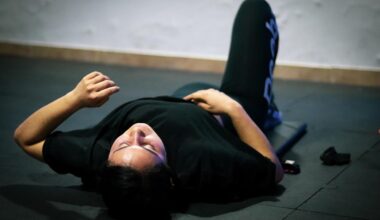Integrating Balance Measurement Tools into Rehabilitation Programs
Effective balance and coordination measurement tools equip rehabilitation specialists with essential insights. These tools help evaluate a patient’s baseline ability and monitor progress throughout their rehabilitation journey. Incorporating balance measurement tools ensures that individualized care plans are developed, addressing specific needs of each patient. Regular assessments using these tools guide therapists in adjusting treatment protocols, enhancing patient outcomes significantly. The use of technology, including digital scales and specialized software, provides a more accurate analysis of balance metrics, offering a modern approach to rehabilitation. Furthermore, exercises can be designed based on feedback obtained from these assessments to focus directly on areas needing improvement. Tools like stabilometry can measure sway patterns, assisting practitioners in understanding balance difficulties that patients may face. Additionally, subjective measures like patient feedback should complement objective assessments, creating a comprehensive perspective on the rehabilitation process. These factors illustrate how crucial it is to integrate balance measurement tools into effective treatment strategies. Without a clear understanding of a patient’s balance capabilities, achieving rehabilitation goals becomes considerably more challenging. In this way, structured integration fosters constructive rehabilitation outcomes. Adaptations made from assessments are essential in rehabilitation settings.
The Role of Technology in Measuring Balance
Rapid technological advancements have transformed how balance and coordination are measured. Instruments such as wearable sensors, pressure mats, and motion analysis systems provide precise data on a patient’s balance abilities. Utilizing these technologies allows practitioners to collect real-time data, which can significantly aid in diagnosis and treatment planning. For example, wearable sensors can track movement patterns and provide feedback on stability during everyday activities. On the other hand, pressure mats assess weight distribution and sway, and help in identifying imbalances that may not be evident during visual assessments alone. The incorporation of video analysis systems further facilitates in-depth evaluations, enabling therapists to observe how patients perform specific tasks under various conditions. Furthermore, the collected data can be analyzed through software that aids in identifying trends and patterns, improving the efficacy of rehabilitation protocols. As a result, integrating technology into treatment plans enhances the recovery process, allowing for timely interventions when needed. In summary, technology’s role in measuring balance cannot be overstated, as it continually provides innovative solutions for enhancing rehabilitation results and optimizing patient care.
Utilizing standardized balance assessment tools can facilitate consistency across rehabilitation programs. Whether in clinics or at home, standardized tests such as the Berg Balance Scale and the Dynamic Gait Index serve as reliable benchmarks. These assessments have been developed through extensive research, ensuring their validity and reliability in measuring balance capabilities. By standardizing assessments, practitioners can communicate effectively about a patient’s progress and share findings within the healthcare community. Data gathered from these tools enable therapists to make informed decisions regarding the patient’s rehabilitation journey. Furthermore, standardized assessments allow for objective comparisons over time, enabling therapists to witness improvements and tailor their approaches accordingly. Such tracking enhances motivation for patients as they witness tangible progress, reinforcing their commitment to the rehabilitation process. Additionally, standardized tools can aid in educating patients about their balance issues. When patients understand their specific limitations and strengths, it can promote a sense of involvement in their recovery. This approach ensures therapy remains patient-centered, a crucial factor as it increases engagement and adherence to prescribed exercises while maintaining rehabilitation goals.
Implementing Balance Training Programs
Effective rehabilitation relies heavily on well-structured balance training programs. Following initial assessments, rehabilitation specialists should design programs focusing on identified weaknesses, ensuring that exercises align with each patient’s capabilities. Incorporating a variety of exercises, including strength training, proprioception drills, and dynamic stability tasks, can enhance balance skills significantly. Incorporating challenges that simulate real-life scenarios allows patients to practice their balance in functional settings. For instance, tasks such as reaching for objects while standing on unstable surfaces can mimic everyday activities, encouraging practical application of skills learned in therapy. Including progressive difficulty is also vital, helping patients steadily improve their balance and coordination over time. Moreover, group exercise sessions can offer social support and foster motivation among patients, further enhancing their rehabilitation experience. Engaging patients in their rehabilitation process encourages exploration and participation, promoting adherence to prescribed exercise regimens. Establishing clear goals helps focus training efforts as well, providing patients with a target to strive toward. Therefore, all these elements emphasize the critical role of tailored balance training programs in effective rehabilitation.
Continuous monitoring and adjustment of rehabilitation plans contribute significantly to patient success. Regular follow-ups should be scheduled to reassess a patient’s balance and coordination levels, ensuring alignment with rehabilitation goals. Although initial assessments provide a baseline, ongoing evaluation is necessary to gauge improvements and adapt treatment plans as required. During follow-ups, therapists should review progress collaboratively with their patients. Engaging patients in discussions about what is working and what isn’t can provide valuable insights, allowing for effective adjustments. Furthermore, monitoring should extend beyond clinical visits through suggested home exercises and at-home balance practices. Encouraging patients to engage in daily activities that promote stability can reinforce clinic-based training. Tools such as journals or apps can aid in tracking daily practices, establishing accountability for patients. Incorporating patient feedback during these evaluations fosters self-advocacy, encouraging patients to become active participants in their rehabilitation journey. In this ongoing process, continuity becomes pivotal, as strides in recovery echo the importance of maintaining motivation and commitment. This nurturing environment not only fosters their growth but also cultivates a sense of teamwork between therapist and patient.
Fostering Patient Engagement and Compliance
Incorporating balance measurement tools into rehabilitation programs can enhance patient engagement and compliance. By providing tangible metrics of progress, patients can visualize their improvements, making the process more compelling. Setting realistic goals using these metrics can foster motivation as patients see their efforts yielding positive outcomes. Therapists should also encourage patients to take ownership of their rehabilitation routines. Empowering them to track their own progress, through journals or application-based interfaces, enhances accountability. Additionally, educational materials regarding the correlations between balance training and daily life activities can be invaluable. Understanding the relevance of exercises promotes adherence, as patients recognize their importance in achieving independence. Providing regular feedback can also create an atmosphere of encouragement. Celebrating small achievements can further enhance patient morale and foster a desire to continue improving. As patients engage actively in their recovery journey, they are more likely to participate consistently in prescribed exercises. Thus, patient engagement plays a critical role in the success of rehabilitation programs. It’s imperative for therapists to work collaboratively with patients, fostering a supportive relationship that encourages progress while addressing any concerns that may arise during the process.
In conclusion, integrating balance measurement tools into rehabilitation programs is essential for enhancing patient outcomes. These tools provide valuable insights that guide practitioners in developing individualized treatment plans, allowing for tailored exercises focused on specific weaknesses. The role of technology continues to evolve, enabling more accurate assessments and real-time data collection that enhances the rehabilitation experience. Standardized tools further promote consistency and communication among healthcare practitioners, providing objective metrics to measure progress effectively. Implementing engaging balance training programs fosters continuous improvement while motivating patients through a structured approach. Monitoring and adjusting treatment plans based on ongoing evaluations ensure that care remains relevant and beneficial throughout the recovery journey. Fostering patient engagement through active participation in their rehabilitation journey reinforces adherence and motivation. Ultimately, successful rehabilitation relies on collaborative efforts between patients and healthcare providers, embracing the incorporation of balance measurement tools to enhance the quality of care. As the field of rehabilitation progresses, remaining innovative and adaptive in integrating these tools will ensure future practices continue to improve patient recovery and well-being.
As we look forward, the future of balance measurement tools in rehabilitation holds immense promise. Emerging technologies and research continue to refine assessment methods, bringing innovative solutions that enhance patient treatment. From virtual reality systems that simulate different environments to advanced wearables that track daily activities, the evolution of tools presents exciting opportunities. An interdisciplinary approach will likely be required, combining the expertise of rehabilitation specialists, physical therapists, and technology developers. By fostering collaboration across different fields, rehabilitation programs can utilize state-of-the-art tools to push the boundaries of patient care further. Moreover, real-time data collection can lead to more personalized interventions, improving patient experience and outcomes. Continuous education and training for therapists are also crucial in keeping pace with advancements in technology and methodology. By embracing these changes and adapting to new paradigms of care, rehabilitation specialists can ensure they are providing the highest quality of service. As balance measurement tools become increasingly sophisticated, the potential for enhancing rehabilitation practices grows. Therefore, ensuring readiness to implement these innovations will be key to driving improved rehabilitation strategies and enriching patients’ lives.


